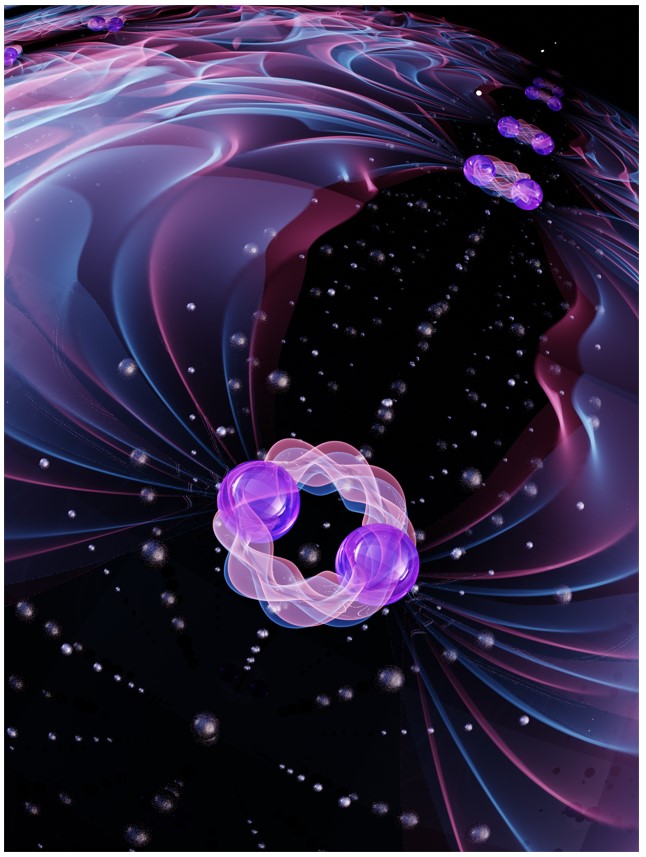
|
 |
Image credit: Emily Edwards. |
|
An international research team consisting of scientists at the University of Maryland, the Institute of Physics in Beijing (Chinese Academy of Sciences), and Lawrence Berkeley National Laboratory have captured experimental evidence that sheds light on the mechanism of high temperature superconductivity in the so-called cuprate superconductors, first discovered in 1986. After decades of research efforts by scientists all over the world, the specific process of superconductivity remains a mystery.
For the first time, systematic experiments carried out by this multi-institutional team have discovered the precise quantitative relationship between the superconducting transition temperature (Tc) and the normal state (above Tc where the material is no longer superconducting) resistivity in the electron-doped cuprate superconductor (La2-xCexCuO4).
Using the combinatorial materials approach, a large compositional variation was generated on a single chip called a combinatorial library. Typically, the combinatorial approach is used to explore and discover new materials via wide screening of compositional landscape in a single experiment. In this study, however, researchers were able to use the ‘library’ to map how superconducting properties and normal state properties of the superconductor evolve with unprecedented resolution and accuracy.
In superconductors below the transition temperature Tc, electrons form pairs, which can then live and carry a current in a coherent state with no electrical resistance. A question the scientific community has been asking is: what specific mechanism causes the pair formation in cuprate superconductors? The relationship observed in the study connects the strength of superconductivity with electron scattering, which acts to break the electron pairs; thus, it carries essential information about the inner workings of this family of superconductor.
In fact, the cuprate superconductors exhibit what is known as “strange metal” behavior where resistance in the normal state increases proportionally with temperature. In contrast, in a typical metal, electrons experience resistance in a number of ways – scattering off of the lattice, impurities, etc. – each scattering having its own temperature dependence, resulting in a complex total temperature dependence.
This “linear in T” behavior in cuprates is believed to reflect the mechanism of superconductivity. The striking relation this team discovered – namely Tc ~ A0.5 where A is the linear temperature coefficient of the resistance – has also been seen in other completely different families of superconductors including the so-called iron-based superconductors, as well as a class of organic superconductors.
“The surprising thing is that these disparate families of superconductors all show the same scaling behavior of Tc and A,” said Kui Jin, the project lead and the Deputy Director of National Lab for Superconductivity at the Institute of Physics in Beijing. “This unexpected universal scaling indicates that there is perhaps a common origin of superconductivity in all these unconventional superconductors.”
One origin that has always been discussed among the community is superconducting pair formation through interaction with spin fluctuations – waves of magnetic spinning tops each located at individual atom sites in the underlying crystal structure of the material.
“Among the superconductor families we compared here, in at least one, the organic superconductor known as (TMTSF)2PF6 , the accepted mechanism of superconductors is spin fluctuations, and therefore it is highly likely that the same, or similar mechanism, is at work in cuprates, too,” Jin said.
The key to unveiling this relationship between Tcand A for the first time was the high-precision composition control achieved on thin film libraries.
“We were able to show that one can control and continuously track the composition of the compound, the parameter x in La2-xCexCuO4, with an accuracy of Δx = 0.0015,” said Ichiro Takeuchi, UMD Professor of Materials Science and Engineering (MSE) and Quantum Materials Center (QMC), a senior author on the study, who helped pioneer the combinatorial approach. “Such high-precision control of composition in this type of materials has never been demonstrated, and this is certainly not possible with bulk chemistry.”
The team looks forward to uncovering the many mysteries left in cuprate superconductors.
“In cuprate superconductivity, it’s always about mapping the evolution of the properties as a function of composition, and we plan to continue systematically going after them using the combinatorial approach,” Takeuchi said.
This study, "Scaling of the strange-metal scattering in unconventional superconductors," was published in Nature on February 16, 2022. For additional information, please follow this link (DOI: 10.1038/s41586-021-04305-5).
February 16, 2022
|